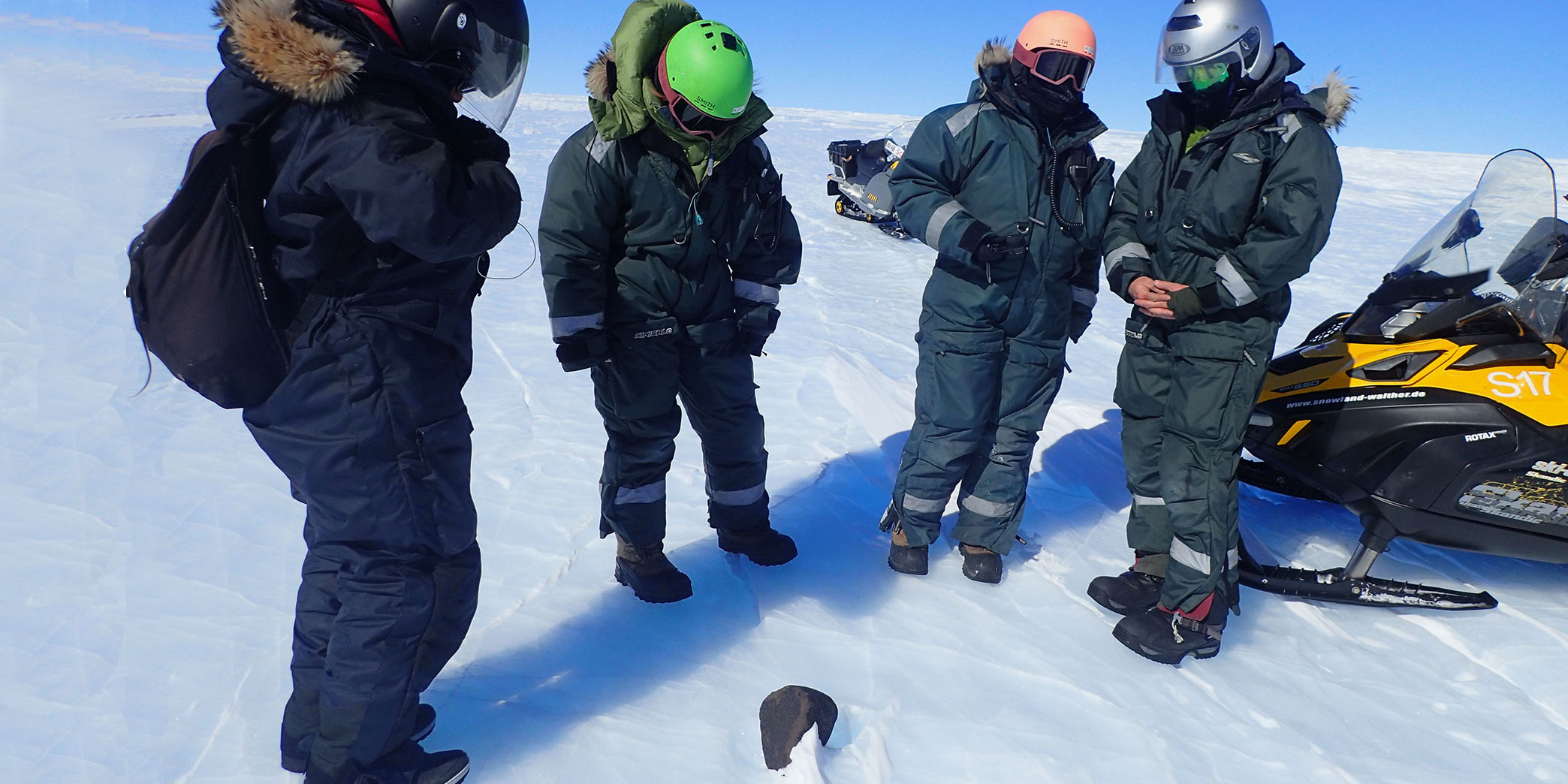Searching for meteorites in Antarctica
Finding meteorites is no easy task. Despite this, a team of scientists including Prof. Maria Schönbächler from ETH Zurich, were successful. Their secret? Going to Antarctica where they found several new meteorites, including a unique piece weighing 7.6 kilograms.

Looking for a needle in a haystack
One can wonder why the team of scientists, composed of members from Switzerland, Belgium and the USA, decided to go to Antarctica and did not search elsewhere for meteorites. There are several good reasons. First, as you are looking for what might seem a normal rock, except that it harbours a dark crust, a desert is an ideal place to scan a large area at once to identify potential meteorites. For that reason, deserts like the Sahara are usually amongst the favourite hunting grounds of meteorite searchers. This is, nevertheless, still like searching for a needle in a haystack, as there are many rocks in a desert. On the other hand, the ice and snow layer of Antarctica, with its white-blue colour, makes any rock stand out as an anomaly, an additional reason for the scientists to go there despite the harsh climate. Lastly, the movements of glaciers transport rocks with them, including meteorites that fell onto the glaciers. In special places where the ice layer is slowly eroded by winds, the rocks and meteorites reappear and accumulate in moraines. This is a good place to look for meteorites. Blue-ice fields are another type of relatively rare areas (1% of the Antarctica surface) resulting from wind-driven erosion. Likewise, those regions are also ideal to scan for precious meteorites.
Fighting the elements
The goal of the team was primarily to scout for new potential concentration regions based on satellite images near the Princess-Elisabeth Antarctica Belgian research station. The South Pole continent is, however, not a very hospitable land. The researchers could nevertheless count on Alain Hubert from the International Polar Foundation, an experienced explorer who knows the region well. He inspected the potential areas first to assure the safety of the expedition. The researchers also obtained crevasses training and Manu Poudelet (International Polar Guide) guided them safely in the field. From the research station to the first target area about sixty kilometres away, the team had to travel carefully across the snow dunes landscape with their snowmobiles, taking major detours to avoid dangerous areas with crevasses, and camping at night in the ice fields. Although it was summer there, the temperature generally reached no more than -10°C and the wind kept blowing quite regularly during their month there. The wind strength even forced the crew to stay at the station for several days.

A winning gamble
This challenging expedition paid off in the end for the international scientific team, who managed to find five meteorites in one of the search areas, the icing on the cake being the 7.6 kilograms one found on their last day, in their last hour of searching. There was also no doubt regarding the nature of this rock: its surface shows clear evidence of a black fusion crust, due to the meteorite heating severely during its atmospheric entry. Less than 0.3 % of the meteorites discovered in Antarctica, are more massive than this one. It is thus an exceptional find amongst the over 40 000 meteorites discovered in Antarctica over the last five decades of exploration. From the four other more modest meteorites, one of the most intriguing weights “only” 150 grams. That being said, it is very dense with a peculiar shape, puzzling the scientists regarding its composition. All the meteorites were carefully packed in special boxes with cooling pads to be warmed up under controlled conditions once back in Europe.

“Antarctica is still largely untouched, it is a beautiful ice desert that merits to be preserved.”Maria Schönbächler
Just the beginning
The meteorites are not the only piece of Antarctica the crew brought back in their luggage. The expedition also took the opportunity to sample fine-grained sediments. They were shared equally amongst the various institutes involved and will be analysed to search for micrometeorites. The five meteorites are curated in Belgium and will be available for each institute involved in the expedition to conduct their research. One of the advantages of meteorites found in Antarctica is that they are usually engulfed in ice after impact, protecting them partially from alterations by the environment until they are revealed. This enables the scientists to better determine the age and compositions of the meteorites, which likely come from the asteroid belt between Mars and Jupiter and are generally older than 4 billion years. Most such meteorites are still unchanged since their formation time, thus providing us with a snapshot of the formation of the solar system. Moreover, meteorites have also brought organic compounds to Earth that might have been key in the development of life. Finding and analysing more meteorites consequently may also bring us closer to understand the origin of life.
The objectives of the mission were fully achieved: from the six areas scouted, all the meteorites were found in a single one, providing interesting prospects for future expeditions in this area.
